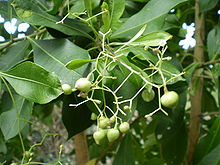Duboisia myoporoides
Appearance
| Corkwood | |
|---|---|

| |
| Scientific classification | |
| Kingdom: | Plantae |
| Clade: | Tracheophytes |
| Clade: | Angiosperms |
| Clade: | Eudicots |
| Clade: | Asterids |
| Order: | Solanales |
| Family: | Solanaceae |
| Genus: | Duboisia |
| Species: | D. myoporoides
|
| Binomial name | |
| Duboisia myoporoides | |
Duboisia myoporoides, or Corkwood, is a shrub or tree native to high-rainfall areas on the margins of rainforest in eastern Australia. It has a thick and corky bark.[1] The leaves are obovate to elliptic in shape, 4–15 cm long and 1–4 cm wide. The small white flowers are produced in clusters. This is followed by globose purple-black berries (not edible).
Uses
The leaves are a commercial source of pharmaceutically useful alkaloids. The same alkaloids render all plant parts poisonous. The leaves contain a number of alkaloids, including hyoscine (scopolamine), used for treating motion sickness, stomach disorders, and the side effects of cancer therapy.[2]

References
- ^ Conn, Barry J. (2001). "Duboisia myoporoides – New South Wales Flora Online". PlantNET – The Plant Information Network System. 2.0. Sydney, Australia: The Royal Botanic Gardens and Domain Trust. Retrieved 28 May 2013.
- ^ Low, Tim (1990). Bush Medicine, A Pharmacopoeia of Natural Remedies. Angus & Robertson. pp. 210–211. ISBN 978-0-207-16462-0.
Further literature
- Foley, Paul (2006). "Duboisia myoporoides: the medical career of a native Australian plant". Historical Records of Australian Science. 17 (1): 31–69. doi:10.1071/hr06001. Retrieved 28 May 2013.
